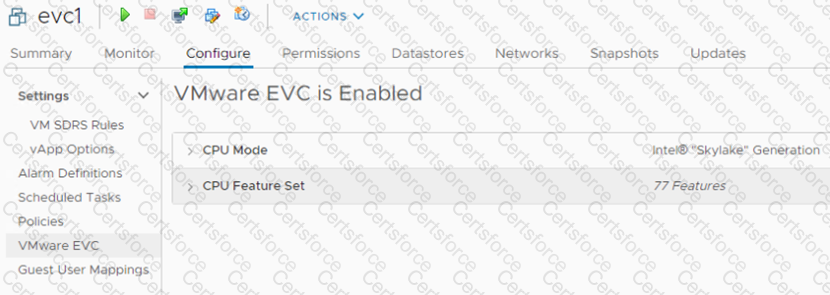Refer to the exhibit.

An administrator is tasked with adding new capacity to an existing software-defined data center (SDDC).
• The SDDC currently hosts two vSphere clusters (ClusterA and ClusterB) with different CPU compatibilities.
• vSphere vMotion and vSphere Distributed Resource Scheduler (DRS) are currently in use in the SDDC.
• The new capacity will be implemented by provisioning four ESXi hosts running a new generation of Intel Skylake CPUs.
• All workload virtual machines (VMs) must support live migration to any cluster in the SDDC.
The administrator noticed the running critical "ever virtual machine (VM) shown in the exhibit is not migrating using vSphere vMotion to the original Clusters A or B.
Which three steps must the administrator take to support this functionality? (Choose three.)
An administrator has been notified that a number of hosts are not compliant with the company policy for time synchronization.
The relevant portion of the policy states:
• All physical servers must synchronize time with an external time source that is accurate to the microsecond. Which step should the administrator take to ensure compliance with the policy?
Which three vSphere features are still supported for Windows-based virtual machines when enabling vSphere's -virtualization-based security feature? (Choose three.)
An administrator needs to consolidate a number of physical servers by migrating the workloads to a software-defined data center solution.
Which VMware solution should the administrator recommend?
An administrator has configured Storage I/O Control (SIOC) on a Virtual Machine File System (VMFS) datastore.
•The datastore supports 30,000 IOPS
•Storage I/O Control has been set to manual
•Storage I/O Control is triggered when latency hits 30 ms
•The datastore contains 3 virtual machines (VMs)
•A gold tier VM
•A silver tier VM
•A bronze tier VM
Assuming the datastore latency does not exceed 29ms, what is the maximum number of IOPS the bronze tier VM is entitled to?
An administrator is configuring vSphere Lifecycle Manager to install patches to a vSphere cluster. The cluster runs workload virtual machines (VMs) that are incompatible with vSphere vMotion, and therefore cannot be live migrated between hosts during the installation of the patches.
Which configuration in vSphere Lifecycle Manager will allow the administrator to reduce the downtime associated with the patching operation without migrating the VMs?
An administrator manually configures a reference ESXi host that meets company security standards for vSphere environments. The administrator now needs to apply all of the security standards to every identically configured host across multiple vSphere clusters within a single VMware vCenter instance.
Which four steps would the administrator complete to meet this requirement? (Choose four.)
A company has two sites: Site A and Site B. The administrator would like to manage the VMware vCenter inventories in both sites from a single vSphere Client session.
Which vCenter feature must be configured?
An administrator runs a two-node vSphere cluster, which contains two domain controller virtual machines (VMs). The administrator wants to ensure that VMs run on separate hosts without interfering with normal maintenance operations.
How should the administrator configure Distributed Resource Scheduler (DRS)?
An administrator notices a Fibre Channel adapter in an ESXi host has been experiencing inconsistent connectivity states.
Which trigger can be used to quickly identify the issue and alert the administrator so that the issue can be resolved?